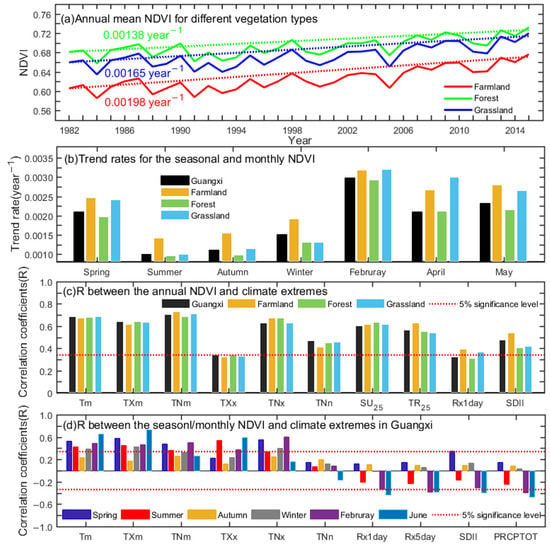Changes in Vegetation Dynamics and Relations with Extreme Climate on Multiple Time Scales in Guangxi, China
Abstract
:1. Introduction
2. Materials and Methods
2.1. Study Area and Data
2.2. Methods
3. Results
3.1. Spatiotemporal Variability of Vegetation Dynamics
3.1.1. Trends of NDVI on an Annual Scale
3.1.2. Trends of NDVI on a Seasonal Scale
3.1.3. Trends of NDVI in Each Month
3.2. Correlations between NDVI and Climate Extremes
3.2.1. Correlations between Annual NDVI and Climate Extremes
3.2.2. Correlations between Seasonal/Monthly NDVI and Climate Extremes
3.3. Time Lags of NDVI Responses to Climate Extremes
4. Discussion
4.1. Variations in Vegetation Dynamics
4.2. Correlations between Vegetation and Climate Extremes
4.3. Lagged Responses of Vegetation to Extreme Climates
4.4. Limitations and Uncertainties
5. Conclusions
- (1)
- The variation rates of NDVI highly differed at different time scales. The annual NDVI significantly increased at a rate of 0.00144 year−1. The greening trend was strongest in spring, followed by winter, autumn and summer. On a monthly scale, the remarkable greening trends occurred in February, May and April.
- (2)
- The effects of extreme climate on vegetation cannot be disentangled from the baseline effect of climate on a time series. The enhanced temperature extremes had positive and strong correlations with green vegetation on an annual scale. With a great seasonal and monthly heterogeneity, the significant positive correlations mostly occurred only in January, February, March, and summer months. Precipitation extremes only had significant and negative relations with vegetation in February and summer months.
- (3)
- The responses of vegetation to climate extremes showed a great spatial heterogeneity, but they showed no significant differences among farmlands, forests and grasslands. The vegetation generally responded to temperature extremes with a time lag of at least one month, and there was mostly a two-month lag relative to precipitation extremes.
Author Contributions
Funding
Institutional Review Board Statement
Informed Consent Statement
Data Availability Statement
Acknowledgments
Conflicts of Interest
References
- Wang, X.; Piao, S.; Ciais, P.; Li, J.; Friedlingstein, P.; Koven, C.; Chen, A. Spring temperature change and its implication in the change of vegetation growth in North America from 1982 to 2006. Proc. Natl. Acad. Sci. USA 2011, 108, 1240–1245. [Google Scholar] [CrossRef] [Green Version]
- Schlesinger, W.H.; Jasechko, S. Transpiration in the global water cycle. Agric. For. Meteorol. 2014, 189, 115–117. [Google Scholar] [CrossRef]
- Yin, Z.; Dekker, S.; van den Hurk, B.; Dijkstra, H. Effects of vegetation structure on biomass accumulation in a Balanced Optimality Structure Vegetation Model (BOSVM v1. 0). Geosci. Model Dev. 2014, 7, 821–845. [Google Scholar] [CrossRef] [Green Version]
- Sun, Y.; Zhang, X.B.; Zwiers, F.W.; Song, L.C.; Wan, H.; Hu, T.; Yin, H.; Ren, G. Rapid increase in the risk of extreme summer heat in eastern China. Nat. Clim. Chang. 2014, 4, 1082–1085. [Google Scholar] [CrossRef]
- Shi, J.; Cui, L.; Wen, K.; Tian, Z.; Wei, P.; Zhang, B. Trends in the consecutive days of temperature and precipitation extremes in China during 1961–2015. Environ. Res. 2018, 161, 381–391. [Google Scholar] [CrossRef]
- Wang, L.; Hu, F.; Hu, J.; Chen, C.; Liu, X.; Zhang, D.; Chen, T.; Miao, Y.; Zhang, L. Multistage spatiotemporal variability of temperature extremes over South China from 1961 to 2018. Theor. Appl. Climatol. 2021, 146, 243–256. [Google Scholar] [CrossRef]
- Vicente-Serrano, S.M.; Gouveia, C.; Camarero, J.J.; Beguería, S.; Trigo, R.; Lópezmoreno, J.I.; Azorínmolina, C.; Pasho, E.; Lorenzolacruz, J.; Revuelto, J. Response of vegetation to drought time-scales across global land biomes. Proc. Natl. Acad. Sci. USA 2013, 110, 52–57. [Google Scholar] [CrossRef] [Green Version]
- Rammig, A.; Wiedermann, M.; Donges, J.F.; Babst, F.; Von Bloh, W.; Frank, D.; Thonicke, K.; Mahecha, M.D. Coincidences of climate extremes and anomalous vegetation responses: Comparing tree ring patterns to simulated productivity. Biogeosciences 2015, 12, 373–385. [Google Scholar] [CrossRef] [Green Version]
- Dubovyk, O.; Landmann, T.; Dietz, A.; Menz, G. Quantifying the impacts of environmental factors on vegetation dynamics over climatic and management gradients of Central Asia. Remote Sens. 2016, 8, 600. [Google Scholar] [CrossRef] [Green Version]
- Wen, Z.; Wu, S.; Chen, J.; Lü, M. NDVI indicated long-term interannual changes in vegetation activities and their responses to climatic and anthropogenic factors in the Three Gorges Reservoir Region, China. Sci. Total Environ. 2017, 574, 947–959. [Google Scholar] [CrossRef]
- Li, C.; Leal Filho, W.; Wang, J.; Yin, J.; Fedoruk, M.; Bao, G.; Bao, Y.; Yin, S.; Yu, S.; Hu, R. An assessment of the impacts of climate extremes on the vegetation in Mongolian Plateau: Using a scenarios-based analysis to support regional adaptation and mitigation options. Ecol. Indic. 2018, 95, 805–814. [Google Scholar] [CrossRef]
- Li, C.; Wang, J.; Hu, R.; Yin, S.; Bao, Y.; Ayal, D.Y. Relationship between vegetation change and extreme climate indices on the Inner Mongolia Plateau, China, from 1982 to 2013. Ecol. Indic. 2018, 89, 101–109. [Google Scholar] [CrossRef]
- Zhao, L.; Dai, A.; Dong, B. Changes in global vegetation activity and its driving factors during 1982–2013. Agric. For. Meteorol. 2018, 249, 198–209. [Google Scholar] [CrossRef]
- Zhang, W.; Wang, L.; Xiang, F.; Qin, W.; Jiang, W. Vegetation dynamics and the relations with climate change at multiple time scales in the Yangtze River and Yellow River Basin, China. Ecol. Indic. 2020, 110, 105892. [Google Scholar] [CrossRef]
- Piao, S.L.; Nan, H.J.; Huntingford, C. Evidence for a weakening relationship between interannual temperature variability and northern vegetation activity. Nat. Commun. 2014, 5, 5058. [Google Scholar] [CrossRef] [Green Version]
- Liu, Y.; Liu, X.; Hu, Y.; Li, S.; Peng, J.; Wang, Y. Analyzing nonlinear variations in terrestrial vegetation in China during 1982–2012. Environ. Monit. Assess. 2015, 187, 722. [Google Scholar] [CrossRef]
- Cui, L.; Wang, L.; Qu, S.; Singh, R.P.; Lai, Z.; Yao, R. Spatiotemporal extremes of temperature and precipitation during 1960–2015 in the Yangtze River Basin (China) and impacts on vegetation dynamics. Theor. Appl. Climatol. 2019, 136, 675–692. [Google Scholar] [CrossRef]
- Li, S.; Wei, F.; Wang, Z.; Shen, J.; Liang, Z.; Wang, H.; Li, S. Spatial heterogeneity and complexity of the impact of extreme climate on vegetation in China. Sustainability 2021, 13, 5748. [Google Scholar] [CrossRef]
- Schuldt, B.; Buras, A.; Arend, M.; Vitasse, Y.; Beierkuhnlein, C.; Damm, A.; Gharun, M.; Grams, T.E.; Hauck, M.; Hajek, P.; et al. A first assessment of the impact of the extreme 2018 summer drought on Central European forests. Basic Appl. Ecol. 2020, 45, 86–103. [Google Scholar] [CrossRef]
- Xu, G.; Zhang, H.; Chen, B.; Zhang, H.; Innes, J.L.; Wang, G.; Yan, J.; Zheng, Y.; Zhu, Z.; Myneni, R.B. Changes in vegetation growth dynamics and relations with climate over China landmass from 1982 to 2011. Remote Sens. 2014, 6, 3263–3283. [Google Scholar] [CrossRef] [Green Version]
- Liu, Y.; Lei, H. Responses of natural vegetation dynamics to climate drivers in China from 1982 to 2011. Remote Sens. 2015, 7, 10243–10268. [Google Scholar] [CrossRef] [Green Version]
- Du, J.; Shu, J.; Yin, J.; Yuan, X.; Jiaerheng, A.; Xiong, S.; He, P.; Liu, W. Analysis on spatio-temporal trends and drivers in vegetation growth during recent decades in Xinjiang, China. Int. J. Appl. Earth Obs. 2015, 38, 216–228. [Google Scholar] [CrossRef]
- Tan, J.; Piao, S.; Chen, A.; Zeng, Z.; Ciais, P.; Janssens, I.A.; Mao, J.; Myneni, R.; Peng, S.; Peñuelas, J.; et al. Seasonally different response of photosynthetic activity to daytime and night-time warming in the Northern Hemisphere. Glob. Chang. Biol. 2014, 21, 377. [Google Scholar] [CrossRef]
- John, R.; Chen, J.; Ou-Yang, Z.-T.; Xiao, J.; Becker, R.; Samanta, A.; Ganguly, S.; Yuan, W.; Batkhishig, O. Vegetation response to extreme climate events on the Mongolian Plateau from 2000 to 2010. Environ. Res. Lett. 2013, 8, 035033. [Google Scholar] [CrossRef]
- Peng, S.; Piao, S.; Ciais, P.; Myneni, R.; Chen, A.; Chevallier, F.; Dolman, A.J.; Janssens, I.A.; Peñuelas, J.; Zhang, G.; et al. Asymmetric effects of daytime and night-time warming on Northern Hemisphere vegetation. Nature 2013, 501, 88–94. [Google Scholar] [CrossRef]
- Hua, W.; Chen, H.; Zhou, L.; Xie, Z.; Qin, M.; Li, X.; Ma, H.; Huang, Q.; Sun, S. Observational Quantification of Climatic and Human Influences on Vegetation Greening in China. Remote Sens. 2017, 9, 425. [Google Scholar] [CrossRef] [Green Version]
- Zhang, Q.; Kong, D.D.; Singh, V.P.; Shi, P.J. Response of vegetation to different time-scales drought across China: Spatiotemporal patterns, causes and implications. Global Planet. Chang. 2017, 152, 1–11. [Google Scholar] [CrossRef] [Green Version]
- Luo, M.; Sa, C.; Meng, F.; Duan, Y.; Liu, T.; Bao, Y. Assessing extreme climatic changes on a monthly scale and their implications for vegetation in Central Asia. J. Clean. Prod. 2020, 271, 122396. [Google Scholar] [CrossRef]
- Piao, S.; Mohammat, A.; Fang, J.; Cai, Q.; Feng, J. NDVI-based increase in growth of temperate grasslands and its responses to climate changes in China. Glob. Environ. Chang. 2006, 16, 340–348. [Google Scholar] [CrossRef]
- Wu, D.; Zhao, X.; Liang, S.; Zhou, T.; Huang, K.; Tang, B.; Zhao, W. Time-lag effects of global vegetation responses to climate change. Glob. Chang. Biol. 2015, 21, 3520–3531. [Google Scholar] [CrossRef]
- Tan, Z.Q.; Tao, H.; Jiang, J.H.; Zhang, Q. Influence of climate extremes on NDVI (Normalized Difference Vegetation Index) in the poyang lake basin, China. Wetlands 2015, 35, 1033–1042. [Google Scholar] [CrossRef]
- Wen, Y.; Liu, X.; Yang, J.; Lin, K.; Du, G. NDVI indicated inter-seasonal non-uniform time-lag responses of terrestrial vegetation growth to daily maximum and minimum temperature. Global Planet. Chang. 2019, 177, 27–38. [Google Scholar] [CrossRef]
- Pan, N.; Feng, X.; Fu, B.; Wang, S.; Ji, F.; Pan, S. Increasing global vegetation browning hidden in overall vegetation greening: Insights from time-varying trends. Remote Sens. Environ. 2018, 214, 59–72. [Google Scholar] [CrossRef]
- Wu, L.; Wang, S.; Bai, X.; Tian, Y.; Luo, G.; Wang, J.; Li, Q.; Chen, F.; Deng, Y.; Yang, Y.; et al. Climate change weakens the positive effect of human activities on karst vegetation productivity restoration in southern China. Ecol. Indic. 2020, 115, 106392. [Google Scholar] [CrossRef]
- Tong, X.; Wang, K.; Yue, Y.; Brandt, M.; Liu, B.; Zhang, C.; Liao, C.; Fensholt, R. Quantifying the effectiveness of ecological restoration projects on long-term vegetation dynamics in the karst regions of Southwest China. Int. J. Appl. Earth Obs. Geoinf. 2017, 54, 105–113. [Google Scholar] [CrossRef] [Green Version]
- Richardson, A.J. Distinguishing vegetation from soil background information. Photogramm. Eng. Remote Sens. 1977, 43, 1541–1552. [Google Scholar]
- Tucker, C.J. Red and photographic infrared linear combinations for monitoring vegetation. Remote Sens. Environ. 1979, 8, 127–150. [Google Scholar] [CrossRef] [Green Version]
- Zhang, C.; Lu, D.; Chen, X.; Zhang, Y.; Maisupova, B.; Tao, Y. The spatiotemporal patterns of vegetation coverage and biomass of the temperate deserts in Central Asia and their relationships with climate controls. Remote Sens. Environ. 2016, 175, 271–281. [Google Scholar] [CrossRef]
- Barichivich, J.; Bria, K.R.; Myneni, R.B.; Osborn, T.J.; Melvin, T.M.; Philippe, C.; Shilong, P.; Compton, T. Large-scale variations in the vegetation growing season and annual cycle of atmospheric CO2 at high northern latitudes from 1950 to 2011. Glob. Chang. Biol. 2013, 19, 3167–3183. [Google Scholar] [CrossRef]
- Zhu, Z.; Bi, J.; Pan, Y.; Ganguly, S.; Anav, A.; Xu, L.; Samanta, A.; Piao, S.; Nemani, R.R.; Myneni, R.B. Global Data Sets of Vegetation Leaf Area Index (LAI)3g and Fraction of Photosynthetically Active Radiation (FPAR)3g Derived from Global Inventory Modeling and Mapping Studies (GIMMS) Normalized Difference Vegetation Index (NDVI3g) for the Period 1981 to 2011. Remote Sens. 2013, 5, 927–948. [Google Scholar]
- Tucker, C.J.; Pinzon, J.E.; Brown, M.E.; Slayback, D.A.; Pak, E.W.; Mahoney, R.; Vermote, E.; Saleous, N.E. An extended AVHRR 8-km NDVDI dataset compatible with MODIS and SPOT vegetation NDVI data. Int. J. Remote Sens. 2005, 26, 4485–4498. [Google Scholar] [CrossRef]
- Zhou, Y.; Fengsong, P.; Yan, X.; Wu, C.; Zhong, R.; Wang, K.; Wang, H.; Cao, Y. Assessing the Impacts of Extreme Climate Events on Vegetation Activity in the North South Transect of Eastern China (NSTEC). Water 2019, 11, 2291. [Google Scholar] [CrossRef] [Green Version]
- Fensholt, R.; Proud, S.R. Evaluation of Earth Observation based global long term vegetation Trends-Comparing GIMMS and MODIS global NDVI time series. Remote Sens. Environ. 2012, 119, 131–147. [Google Scholar] [CrossRef]
- Sarmah, S.; Jia, G.; Zhang, A.; Singha, M. Assessing seasonal trends and variability of vegetation growth from NDVI3g, MODIS NDVI and EVI over South Asia. Remote Sens. Lett. 2018, 9, 1195–1204. [Google Scholar] [CrossRef]
- Zeng, F.W.; Collatz, G.J.; Pinzon, J.E.; Ivanoff, A. Evaluating and quantifying the climate-driven interannual variability in Global Inventory Modeling and Mapping Studies (GIMMS) Normalized Difference Vegetation Index (NDVI3g) at Global Scales. Remote Sens. 2013, 5, 3918–3950. [Google Scholar] [CrossRef] [Green Version]
- Cui, L.; Wang, L.; Singh, R.P.; Lai, Z.; Jiang, L.; Yao, R. Association analysis between spatiotemporal variation of vegetation greenness and precipitation/temperature in the Yangtze River Basin (China). Environ. Sci. Pollut. Res. 2018, 25, 21867–21878. [Google Scholar] [CrossRef]
- Easterling, D.R.; Alexander, L.V.; Mokssit, A.; Detemmerman, V. CCI/CLIVAR workshop to develop priority climate indices. Bull. Amer. Meteor. Soc. 2003, 84, 1403–1407. [Google Scholar]
- Sen, P.K. Estimates of the regression coefficient based on Kendall’s tau. J. Am. Stat. Assoc. 1968, 63, 1379–1389. [Google Scholar] [CrossRef]
- Mann, H.B. Nonparametric tests against trend. Econom. J. Econom. Soc. 1945, 13, 245–259. [Google Scholar] [CrossRef]
- Zhou, Y.; Zhang, L.; Fensholt, R.; Wang, K.; Vitkovskaya, I.; Tian, F. Climate contributions to vegetation variations in Central Asian drylands: Pre- and post-USSR collapse. Remote Sens. 2015, 7, 2449–2470. [Google Scholar] [CrossRef] [Green Version]
- Zhao, J.; Huang, S.; Huang, Q.; Wang, H.; Leng, G.; Fang, W. Time-lagged response of vegetation dynamics to climatic and teleconnection factors. Catena 2020, 189, 104474. [Google Scholar] [CrossRef]
- Mulder, C.P.H.; Iles, D.T.; Rockwell, R.F. Increased variance in temperature and lag effects alter phenological responses to rapid warming in a subarctic plant community. Glob. Chang. Biol. 2016, 23, 801–814. [Google Scholar] [CrossRef] [PubMed]
- Yan, H.; Yu, Q.; Zhu, Z.; Myneni, R.B.; Yan, H.; Wang, S.; Shugart, H.H. Diagnostic analysis of interannual variation of global land evapotranspiration over 1982–2011: Assessing the impact of ENSO. J. Geophys. Res. Atmos. 2013, 118, 8969–8983. [Google Scholar] [CrossRef]
- Piao, S.; Friedlingstein, P.; Ciais, P.; Viovy, N.; Demarty, J. Growing season extension and its impact on terrestrial carbon cycle in the Northern Hemisphere over the past 2 decades. Glob. Biogeochem. Cycles 2007, 21, GB3018. [Google Scholar] [CrossRef]
- Zhang, T.; Yang, S.; Guo, R.; Guo, J. Correction: Warming and nitrogen addition alter photosynthetic pigments, sugars and nutrients in a temperate meadow ecosystem. PLoS ONE 2016, 11, e0158249. [Google Scholar] [CrossRef] [PubMed] [Green Version]
- Zhang, Q.Y.; Wu, S.H.; Zhao, D.S.; Dai, E.F. Responses of growing season vegetation changes to climatic factors in inner mongolia grassland. J. Nat. Res. 2013, 28, 754–764. [Google Scholar]
- Chen, T.; De Jeu, R.; Liu, Y.; Van der Werf, G.; Dolman, A. Using satellite based soil moisture to quantify the water driven variability in NDVI: A case study over mainland Australia. Remote Sens. Environ. 2014, 140, 330–338. [Google Scholar] [CrossRef]
- Dong, Y.; Yin, D.; Li, X.; Huang, J.; Su, W.; Li, X.; Wang, H. Spatial-temporal evolution of vegetation NDVI in association with climatic, environmental and anthropogenic factors in the Loess Plateau, China during 2000–2015: Quantitative analysis based on Geographical Detector Model. Remote Sens. 2021, 13, 4380. [Google Scholar] [CrossRef]
- Julien, Y.; Sobrino, J.A. Comparison of cloud-reconstruction methods for time series of composite NDVI data. Remote Sens. Environ. 2010, 114, 618–625. [Google Scholar] [CrossRef]
- Brantley, S.T.; Zinnert, J.C.; Young, D.R. Application of hyperspectral vegetation indices to detect variations in high leaf area index temperate shrub thicket canopies. Remote Sens. Environ. 2011, 115, 514–523. [Google Scholar] [CrossRef] [Green Version]
- Lloret, F.; Escudero, A.; Lriondo, J.M.; Martínez-Vilalta, J.; Valladares, F. Extreme climate events and vegetation: The role of stabilizing processes. Glob. Chang. Biol. 2012, 18, 797–805. [Google Scholar] [CrossRef]
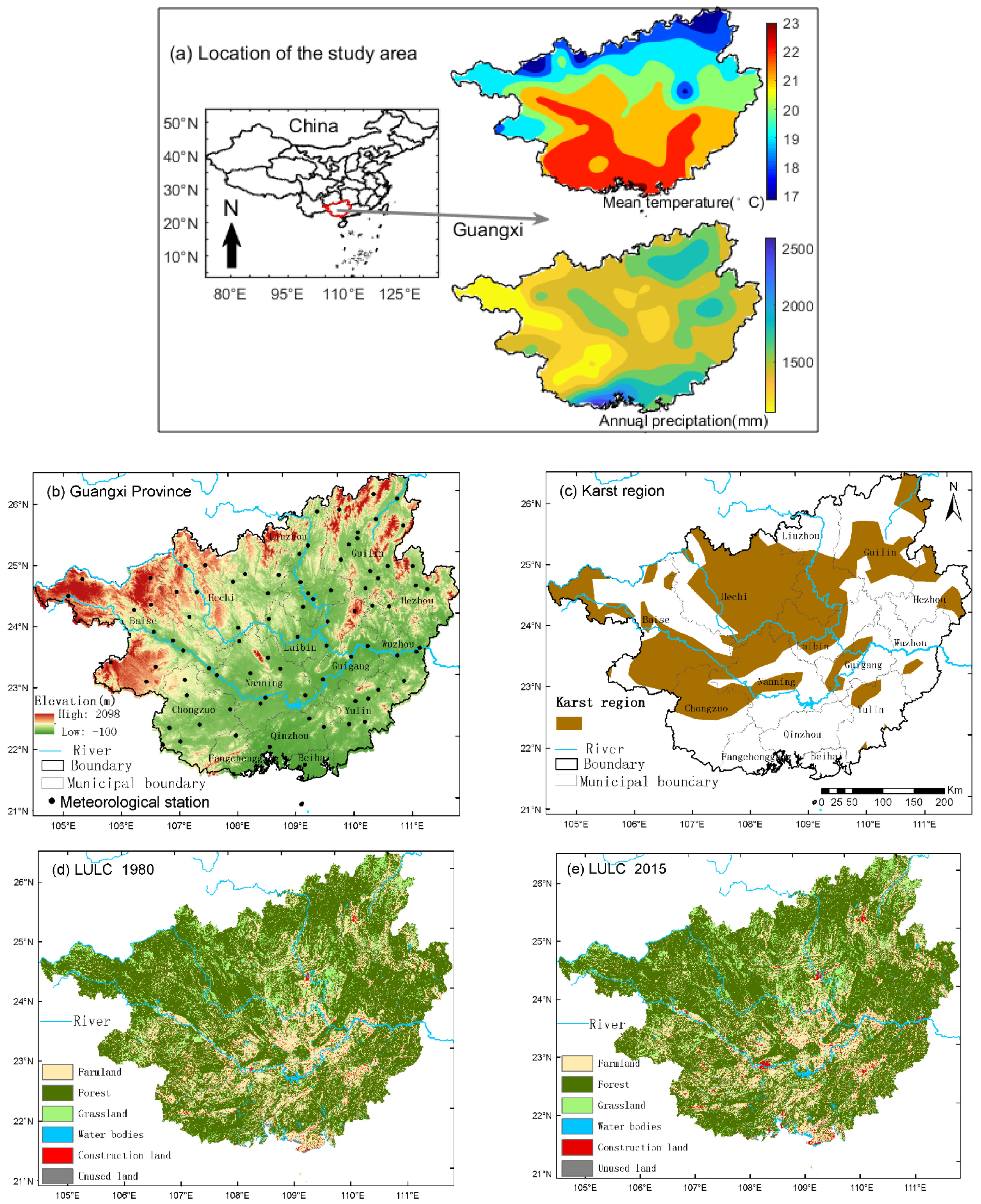

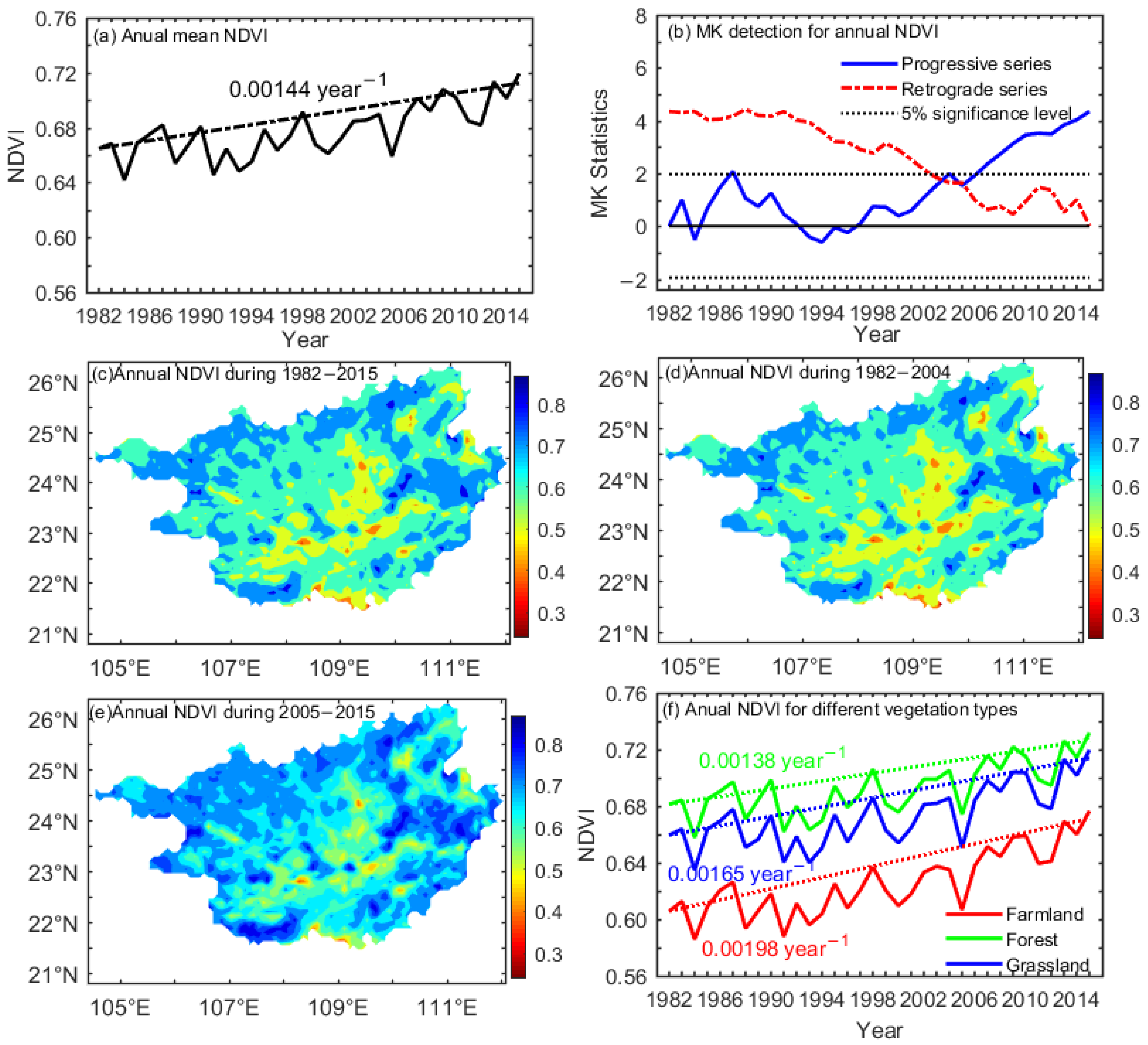

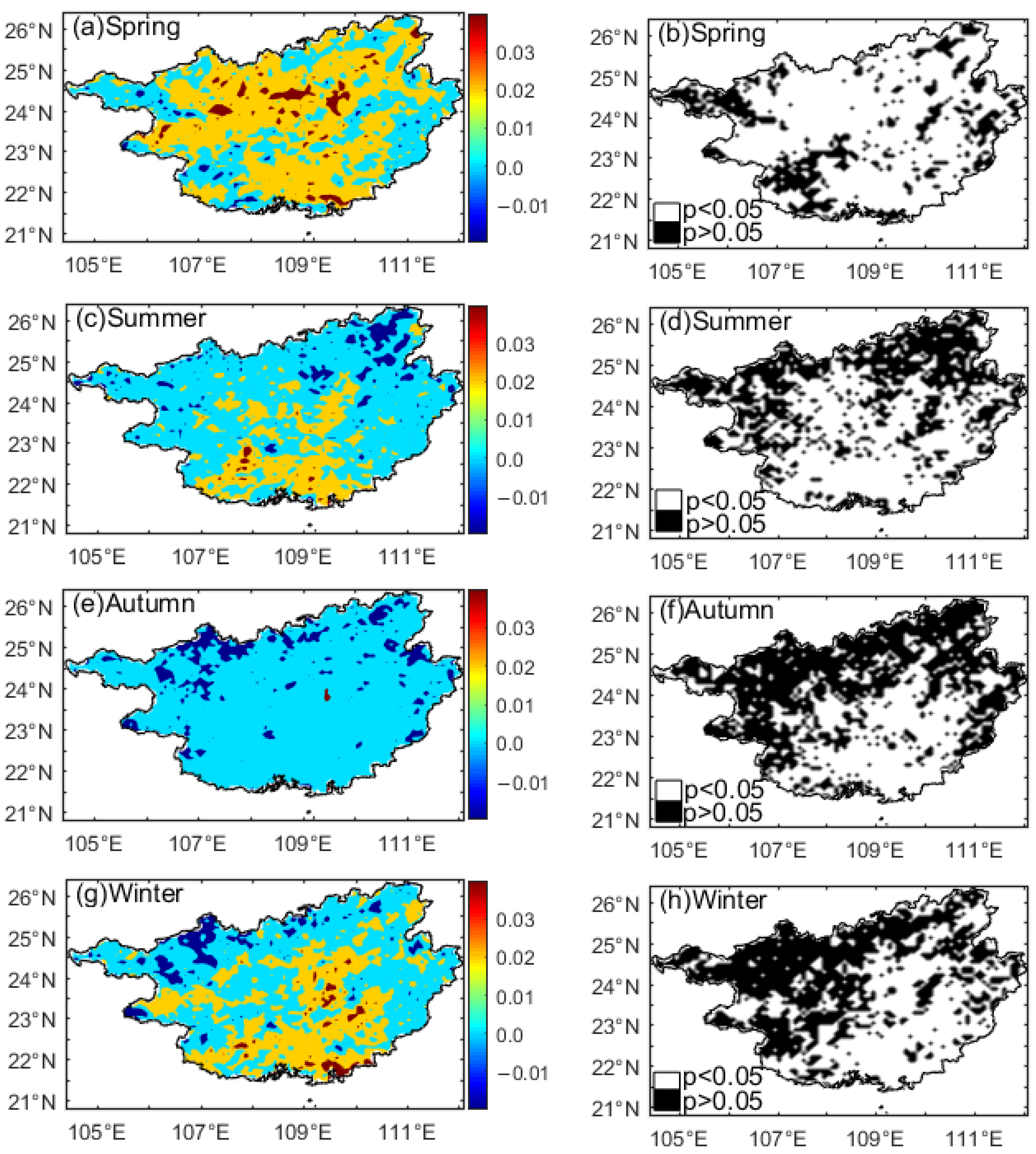
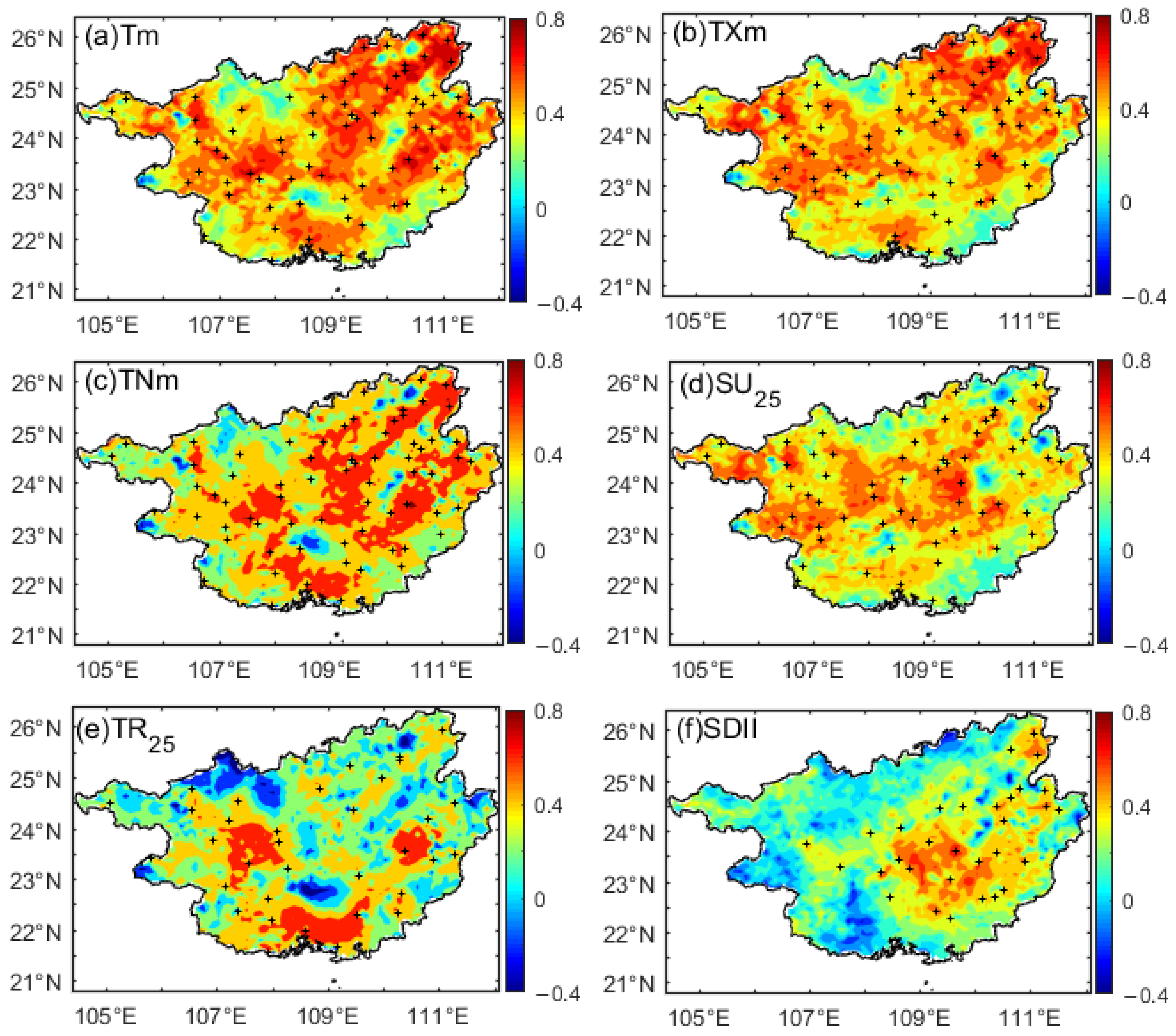

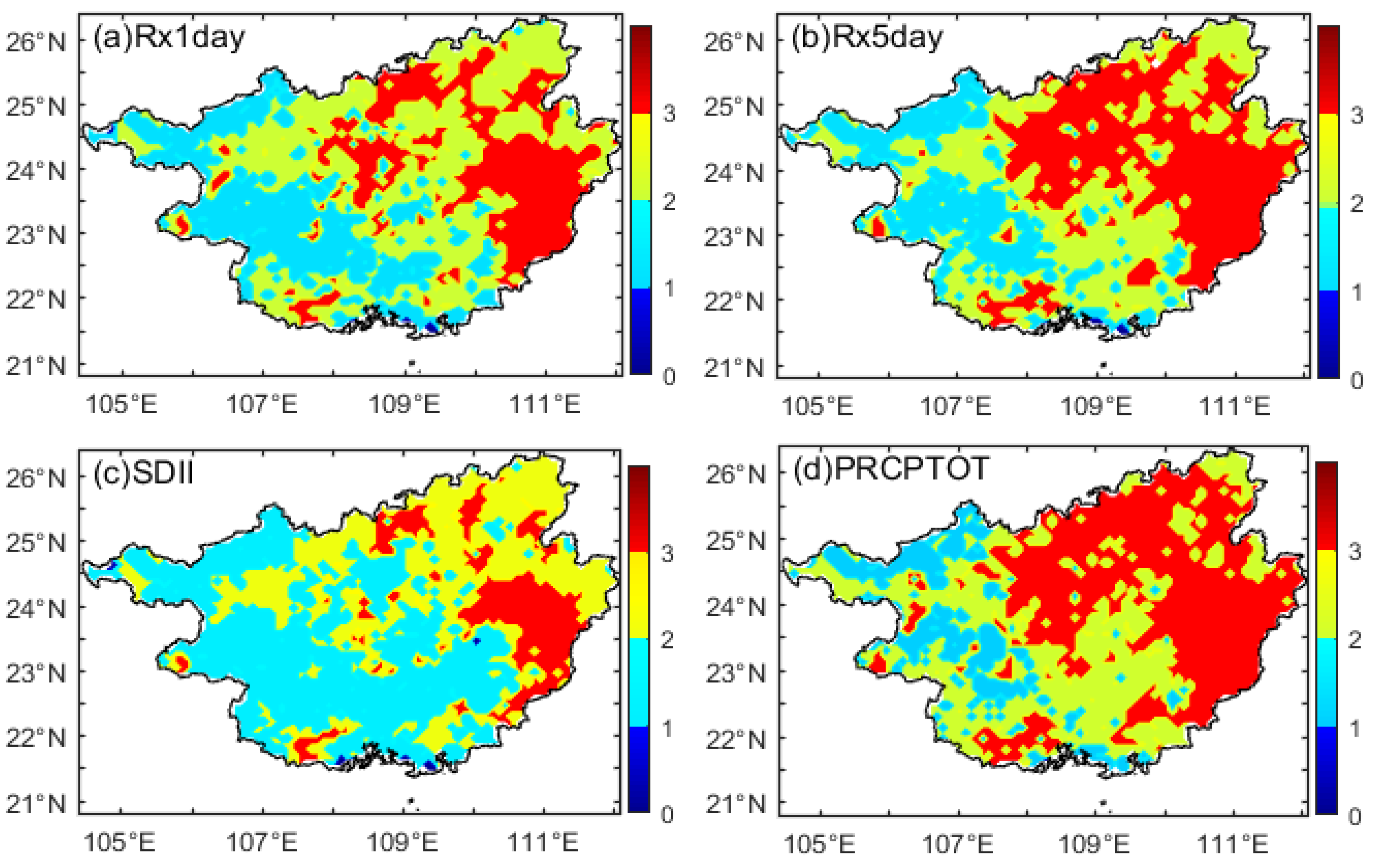
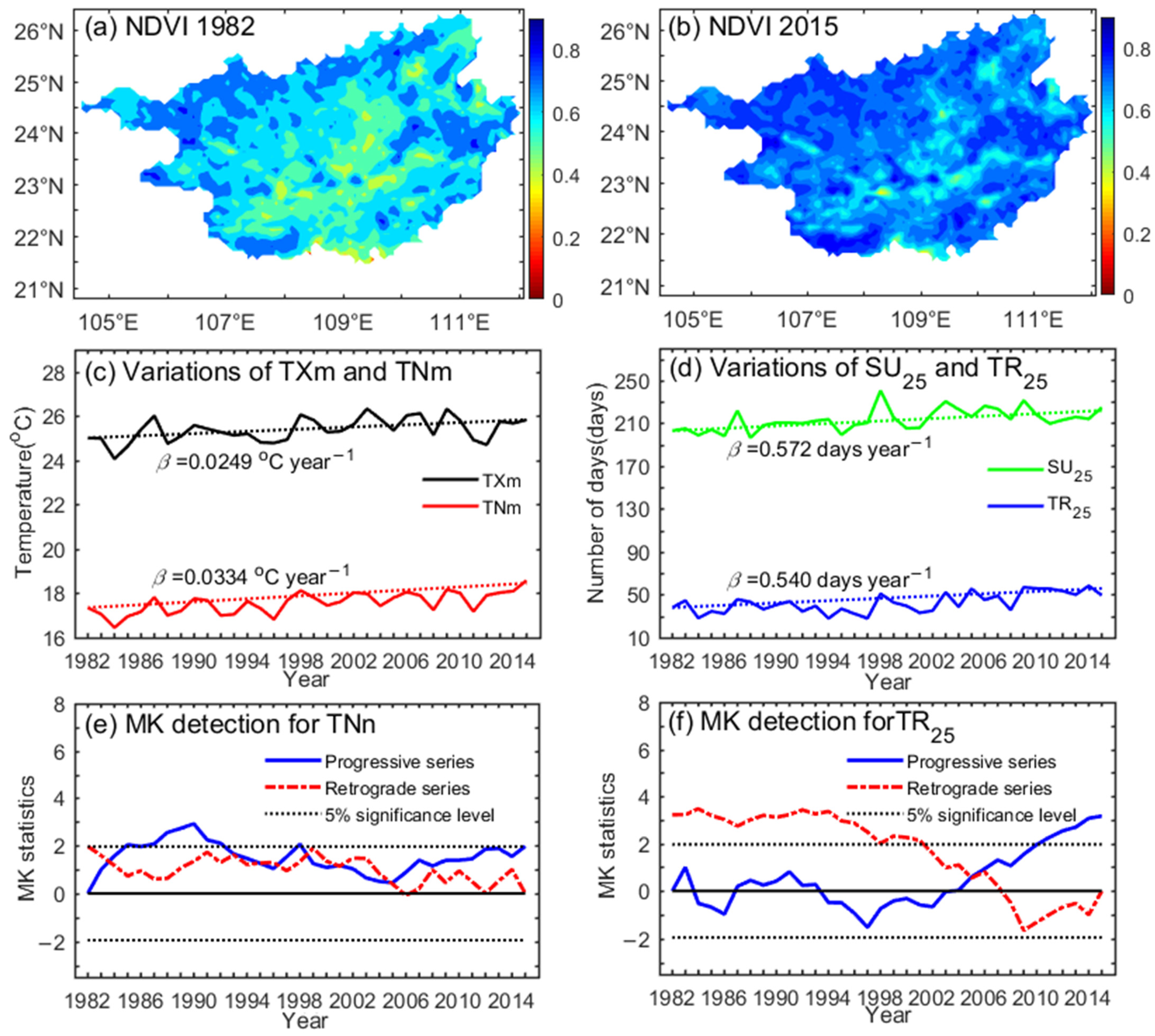

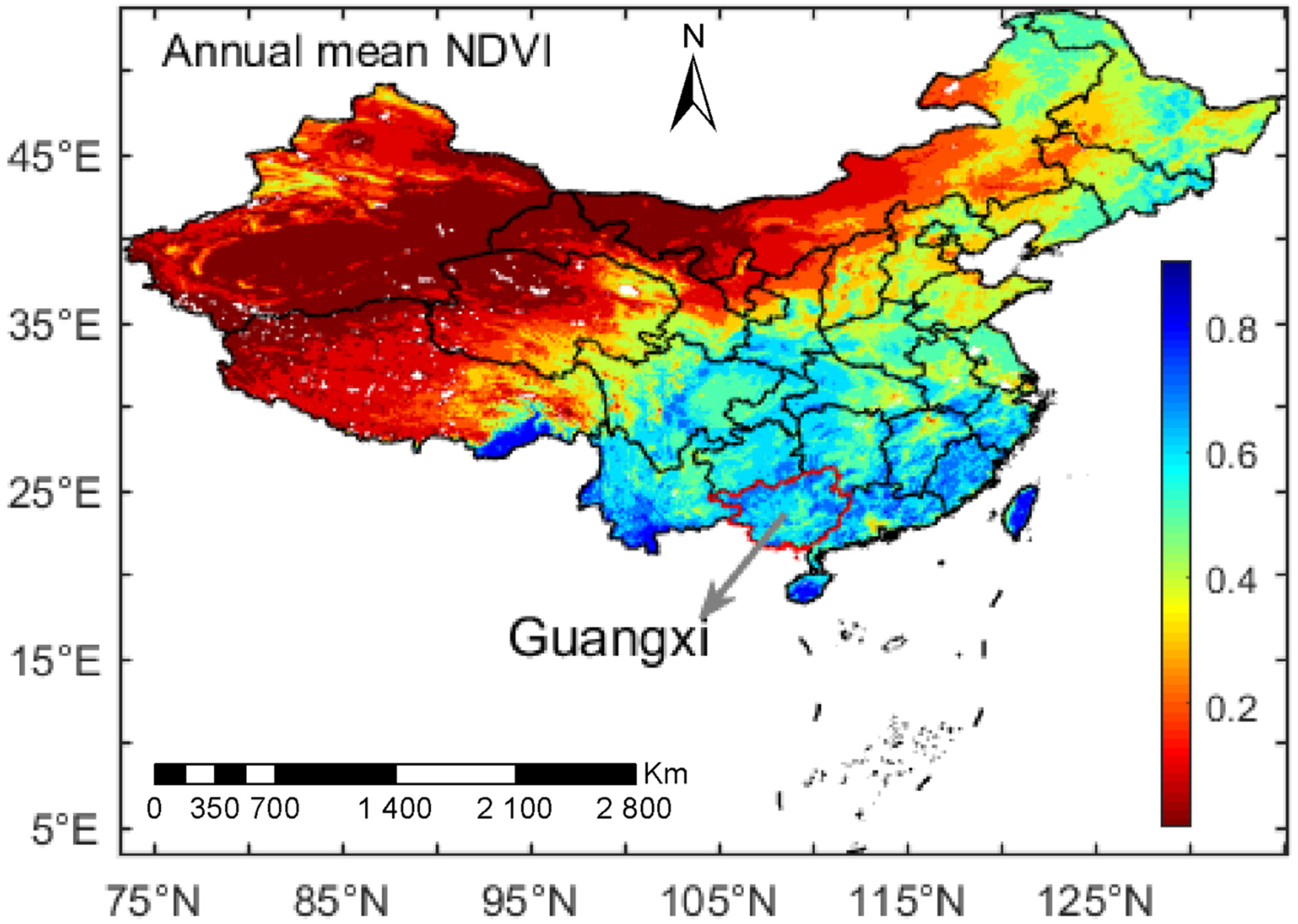
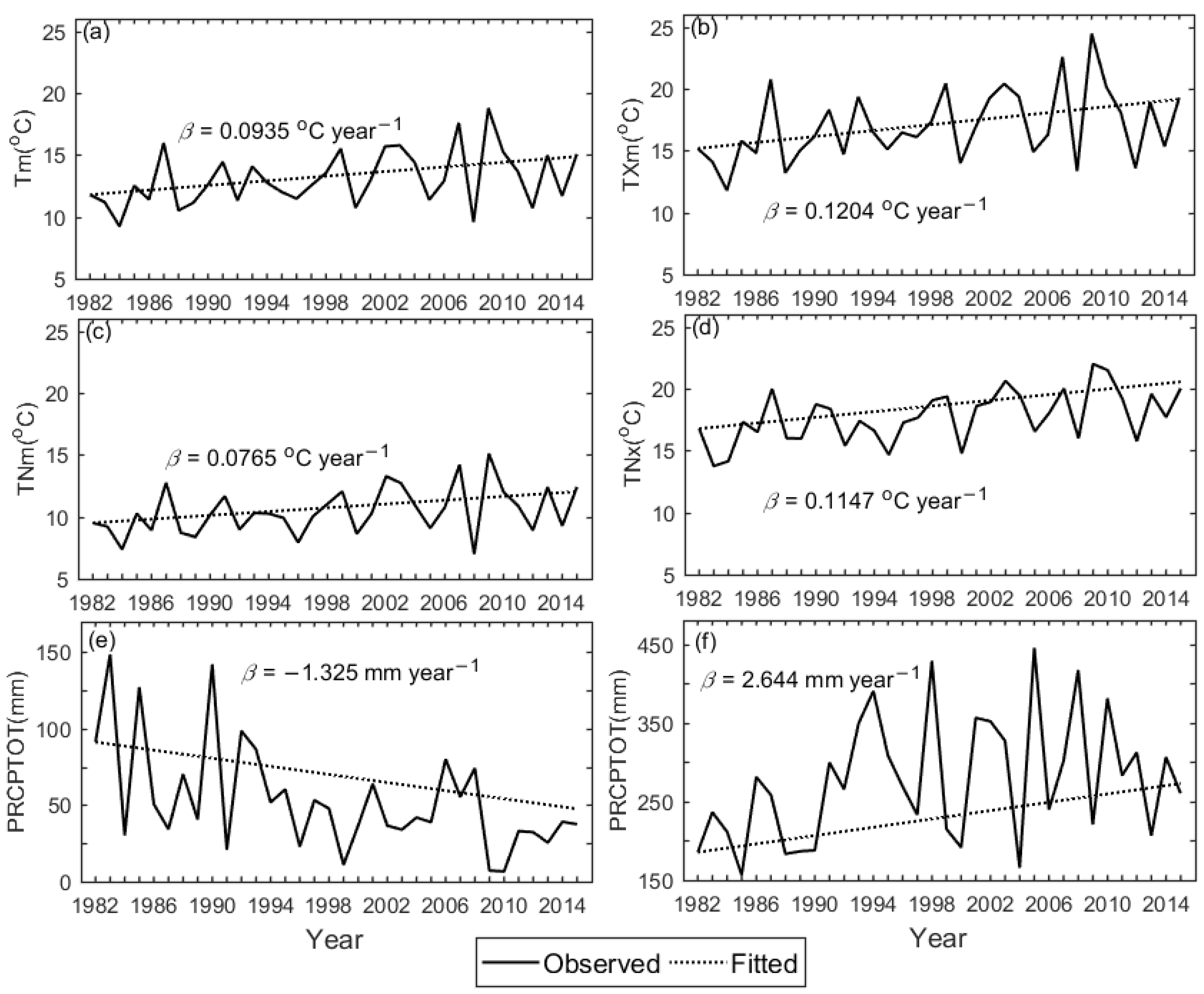
| Name | Data Source | Spatial Scale |
|---|---|---|
| Daily weather data | China Meteorological Administration (http://data.cma.cn/, accessed on 15 October 2019) | - |
| Karst boundary data | World Map of Carbonate Rock Outcrops (http://web.env.auckland.ac.nz/our-research/karst/, accessed on 14 June 2017) | - |
| LULC data | Resource and Environment Science and Data Center, Chinese Academy of Sciences (https://www.resdc.cn/, accessed on 10 October 2021) | 1 km |
| Digital Elevation data | Resource and Environment Science and Data Center, Chinese Academy of Sciences (https://www.resdc.cn/, accessed on 10 October 2021) | 250 m |
| GIMMS NDVI3g data | National Oceanic and Atmospheric Administration (https://www.nasa.gov/nex, accessed on 7 December 2020) | 1/12° (about 8 km) |
| Indices | Indicator Name | Definition | Unit |
|---|---|---|---|
| Tm | Mean temperature | Mean value of daily mean temperature | °C |
| TXm | Maximum temperature | Mean value of daily maximum temperature (TX) | °C |
| TNm | Minimum temperature | Mean value of daily minimum temperature (TN) | °C |
| DTR | Diurnal temperature range | Mean difference between TX and TN | °C |
| TXx | Max TX | Maximum value of daily maximum temperature | °C |
| TNx | Max TN | Maximum value of daily minimum temperature | °C |
| TXn | Min TX | Minimum value of daily maximum temperature | °C |
| TNn | Min TN | Minimum value of daily minimum temperature | °C |
| GSL | Growing season length | Annually count between first span of at least 6 consecutive days with Tm > 10 °C and first span after July 1 of 6 days with Tm < 10 °C | days |
| SU25 | Summer days | Number of days with daily maximum temperature > 25 °C | days |
| TR25 | Tropical nights | Number of days with daily minimum temperature > 25 °C | days |
| Rx1day | Max 1-day precipitation amount | Maximum 1-day precipitation | mm |
| Rx5day | Max 5-day precipitation amount | Maximum consecutive 5-day precipitation | mm |
| SDII | Simple daily intensity index | Total precipitation divided by the number of wet days (defined as PRCP ≥ 1.0 mm) in the year | mm/day |
| PRCPTOT | Total wet-day precipitation | Total precipitation in wet days (PRCP ≥ 1 mm) | mm |
| R20 | Number of very heavy precipitation days | Annual count of days when PRCP ≥ 20 mm | days |
| R50 | Rainstorm | Annual count of days when PRCP ≥ 50 mm | days |
| Guangxi | Farmlands | Forests | Grasslands | |
|---|---|---|---|---|
| Spring | 0.0021 ** | 0.0025 ** | 0.0020 ** | 0.0024 ** |
| Summer | 0.0010 ** | 0.0014 ** | 0.0010 ** | 0.0010 ** |
| Autumn | 0.0011 * | 0.0015 ** | 0.0010 * | 0.0011 * |
| Winter | 0.0015 * | 0.0019 ** | 0.0013 | 0.0013 * |
| January | 0.0006 | 0.0011 | 0.0005 | 0.0003 |
| February | 0.0030 ** | 0.0032 ** | 0.0029 * | 0.0032 ** |
| March | 0.0013 | 0.0018 | 0.0011 | 0.0014 |
| April | 0.0021 * | 0.0027 ** | 0.0021 ** | 0.0030 ** |
| May | 0.0023 ** | 0.0028 ** | 0.0022 ** | 0.0026 ** |
| June | 0.0004 | 0.0008 | 0.0004 | 0.0001 |
| July | 0.0015 ** | 0.0021 ** | 0.0014 ** | 0.0016 ** |
| August | 0.0014 ** | 0.0020 ** | 0.0013 ** | 0.0017 ** |
| September | 0.0014 ** | 0.0017 ** | 0.0012 * | 0.0014 * |
| October | 0.0005 | 0.0007 | 0.0003 | 0.0004 |
| November | 0.0014 * | 0.0020 * | 0.0010 | 0.0013 ** |
| December | 0.0009 | 0.0016 | 0.0007 | 0.0010 |
| Tm | TXm | TNm | DTR | TXx | TNx | TXn | TNn | GSL | SU25 | TR25 | Rx1day | Rx5day | SDII | R20 | R50 | PRCPTOT | |
|---|---|---|---|---|---|---|---|---|---|---|---|---|---|---|---|---|---|
| Guangxi | 0.683 ** | 0.641 ** | 0.705 ** | 0.027 | 0.342 * | 0.630 ** | 0.081 | 0.466 ** | 0.136 | 0.605 ** | 0.562 ** | 0.324 | 0.181 | 0.472 ** | 0.234 | 0.242 | 0.175 |
| Farmlands | 0.673 ** | 0.616 ** | 0.728 ** | −0.029 | 0.322 | 0.674 ** | 0.113 | 0.412 * | 0.092 | 0.615 ** | 0.625 ** | 0.392 * | 0.279 | 0.539 ** | 0.264 | 0.253 | 0.197 |
| Forests | 0.680 ** | 0.640 ** | 0.687 ** | 0.081 | 0.338 | 0.675 ** | 0.117 | 0.450 ** | 0.158 | 0.631 ** | 0.551 ** | 0.312 | 0.132 | 0.406 * | 0.160 | 0.132 | 0.092 |
| Grasslands | 0.684 ** | 0.634 ** | 0.712 ** | 0.025 | 0.331 | 0.626 ** | 0.083 | 0.456 ** | 0.195 | 0.617 ** | 0.537 ** | 0.368 * | 0.169 | 0.415 * | 0.184 | 0.195 | 0.126 |
| Tm | TXm | TNm | DTR | TXx | TNx | TXn | TNn | Rx1day | Rx5day | SDII | PRCPTOT | |
|---|---|---|---|---|---|---|---|---|---|---|---|---|
| Spring | 0.526 ** | 0.577 ** | 0.477 ** | 0.432 * | 0.226 | 0.547 ** | 0.239 | 0.143 | 0.121 | 0.143 | 0.347 * | 0.145 |
| Summer | 0.425 * | 0.450 ** | 0.363 * | 0.271 | 0.543 ** | 0.341 * | 0.097 | 0.069 | −0.215 | −0.240 | −0.172 | −0.241 |
| Autumn | 0.239 | 0.169 | 0.264 | −0.096 | 0.119 | 0.245 | 0.021 | 0.195 | 0.105 | 0.094 | 0.094 | 0.083 |
| Winter | 0.387 * | 0.429 * | 0.327 | 0.301 | 0.238 | 0.405 * | 0.287 | 0.118 | −0.015 | 0.054 | 0.129 | 0.027 |
| January | 0.335 | 0.486 ** | 0.129 | 0.587 ** | 0.448 ** | 0.386 * | 0.155 | −0.051 | −0.058 | −0.001 | 0.052 | −0.097 |
| February | 0.483 ** | 0.465 ** | 0.497 ** | 0.298 | 0.378 * | 0.597 ** | 0.278 | 0.082 | −0.335 | −0.384 * | −0.305 | −0.398 * |
| March | 0.513 ** | 0.560 ** | 0.438 ** | 0.489 ** | 0.291 | 0.368 * | 0.244 | 0.184 | 0.246 | 0.227 | 0.407 * | 0.250 |
| April | 0.263 | 0.402 * | 0.109 | 0.554 ** | 0.207 | 0.217 | −0.115 | −0.180 | −0.089 | −0.083 | 0.140 | −0.083 |
| May | 0.129 | 0.273 | 0.063 | 0.315 | 0.174 | 0.332 | 0.211 | 0.035 | 0.006 | −0.086 | 0.126 | −0.086 |
| June | 0.651 ** | 0.732 ** | 0.255 | 0.585 ** | 0.584 ** | 0.163 | 0.304 | −0.177 | −0.441 ** | −0.384 * | −0.399 * | −0.480 ** |
| July | 0.350 * | 0.408 * | 0.237 | 0.348 * | 0.389 * | 0.273 | 0.174 | 0.144 | −0.185 | −0.286 | −0.197 | −0.348 * |
| August | 0.368 * | 0.388 * | 0.307 | 0.305 | 0.477 ** | 0.447 ** | 0.051 | 0.019 | −0.236 | −0.316 | −0.107 | −0.347 * |
| September | −0.056 | 0.032 | −0.105 | 0.140 | −0.063 | 0.237 | −0.061 | −0.246 | −0.045 | −0.062 | 0.006 | −0.120 |
| October | −0.033 | 0.220 | −0.204 | 0.514 ** | −0.072 | −0.057 | 0.214 | −0.144 | −0.168 | −0.234 | −0.184 | −0.243 |
| November | −0.160 | −0.106 | −0.132 | 0.033 | 0.047 | 0.058 | 0.003 | −0.133 | −0.006 | 0.059 | −0.009 | 0.068 |
| December | −0.037 | 0.170 | −0.155 | 0.278 | 0.025 | −0.056 | 0.117 | −0.176 | −0.099 | 0.006 | −0.015 | 0.048 |
| Tm | TXm | TNm | DTR | TXx | TNx | TXn | TNn | Rx1day | Rx5day | SDII | PRECPTOT | |
|---|---|---|---|---|---|---|---|---|---|---|---|---|
| 0 | 0.614 ** | 0.664 ** | 0.576 ** | 0.584 ** | 0.539 ** | 0.546 ** | 0.646 ** | 0.551 ** | 0.311 ** | 0.262 ** | 0.384 ** | 0.233 ** |
| 1 | 0.802 ** | 0.805 ** | 0.796 ** | 0.267 ** | 0.759 ** | 0.786 ** | 0.764 ** | 0.760 ** | 0.536 ** | 0.487 ** | 0.573 ** | 0.482 ** |
| 2 | 0.765 ** | 0.735 ** | 0.780 ** | 0.004 | 0.770 ** | 0.787 ** | 0.694 ** | 0.752 ** | 0.615 ** | 0.579 ** | 0.610 ** | 0.588 ** |
| 3 | 0.504 ** | 0.450 ** | 0.538 ** | −0.271 ** | 0.527 ** | 0.549 ** | 0.434 ** | 0.540 ** | 0.568 ** | 0.561 ** | 0.524 ** | 0.587 ** |
Publisher’s Note: MDPI stays neutral with regard to jurisdictional claims in published maps and institutional affiliations. |
© 2022 by the authors. Licensee MDPI, Basel, Switzerland. This article is an open access article distributed under the terms and conditions of the Creative Commons Attribution (CC BY) license (https://creativecommons.org/licenses/by/4.0/).
Share and Cite
Wang, L.; Hu, F.; Miao, Y.; Zhang, C.; Zhang, L.; Luo, M. Changes in Vegetation Dynamics and Relations with Extreme Climate on Multiple Time Scales in Guangxi, China. Remote Sens. 2022, 14, 2013. https://doi.org/10.3390/rs14092013
Wang L, Hu F, Miao Y, Zhang C, Zhang L, Luo M. Changes in Vegetation Dynamics and Relations with Extreme Climate on Multiple Time Scales in Guangxi, China. Remote Sensing. 2022; 14(9):2013. https://doi.org/10.3390/rs14092013
Chicago/Turabian StyleWang, Leidi, Fei Hu, Yuchen Miao, Caiyue Zhang, Lei Zhang, and Mingzhu Luo. 2022. "Changes in Vegetation Dynamics and Relations with Extreme Climate on Multiple Time Scales in Guangxi, China" Remote Sensing 14, no. 9: 2013. https://doi.org/10.3390/rs14092013
APA StyleWang, L., Hu, F., Miao, Y., Zhang, C., Zhang, L., & Luo, M. (2022). Changes in Vegetation Dynamics and Relations with Extreme Climate on Multiple Time Scales in Guangxi, China. Remote Sensing, 14(9), 2013. https://doi.org/10.3390/rs14092013






